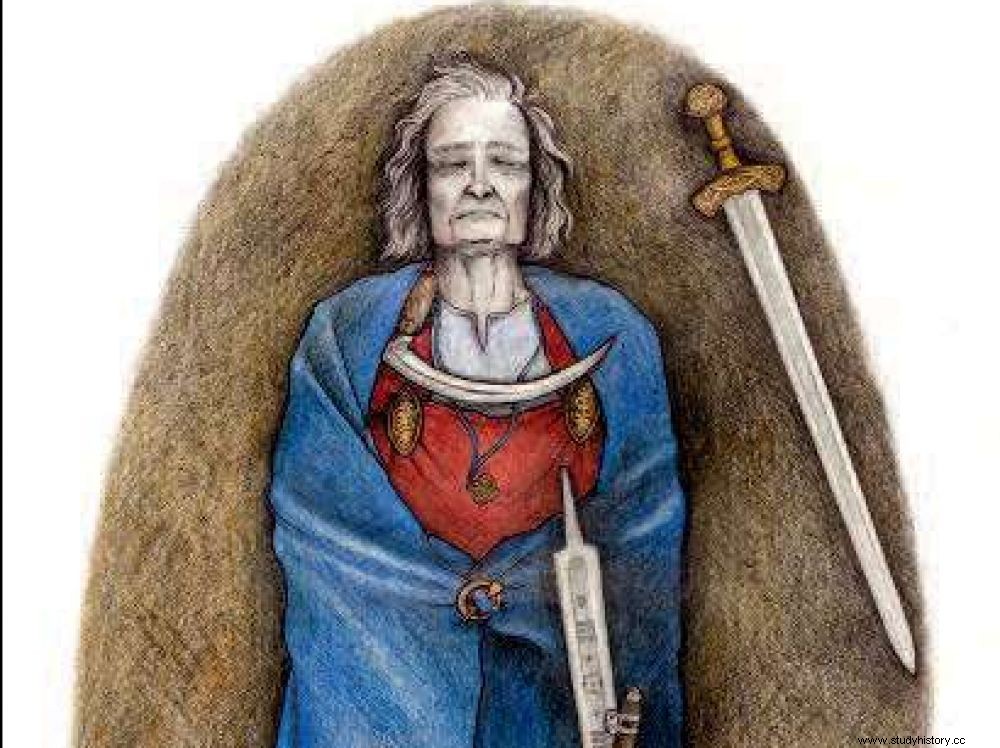This body discovered in Finland belongs to a man with Klinefelter syndrome, characterized by an extra sex chromosome.

The body, dressed in a woman's coat held by two brooches, had been buried with swords (illustration).
This article is from the magazine Sciences et Avenir - La Recherche n°896 dated October 2021.
Man or woman ? The controversy had been going on since the discovery of this body in 1968 in Suontaka Vesitorninmäki, in southern Finland. But DNA analysis of remains discovered in a medieval tomb, dated between 1050 and 1300 CE, shows that the person who lay next to his sword was in fact... intersex. That is, a man with Klinefelter syndrome, characterized by an extra sex chromosome. Where women have a pair of XX chromosomes and men XY, this character was therefore XXY for a total of 47 chromosomes instead of 46. This is revealed by a Finnish-Germanic study published in European Journal of Archeology which thus specifies the masculine but infertile character of the warrior.
A typical female costume
When the body was discovered, the archaeologists had reconstructed the individual's clothing, a blue woolen garment, held by two brooches located under the shoulders, described as "typical female costume of the time" .
This article is from the magazine Sciences et Avenir - La Recherche n°896 dated October 2021.
Man or woman ? The controversy had been going on since the discovery of this body in 1968 in Suontaka Vesitorninmäki, in southern Finland. But DNA analysis of remains discovered in a medieval tomb, dated between 1050 and 1300 CE, shows that the person who lay next to his sword was in fact... intersex. That is, a man with Klinefelter syndrome, characterized by an extra sex chromosome. Where women have a pair of XX chromosomes and men XY, this character was therefore XXY for a total of 47 chromosomes instead of 46. This is revealed by a Finnish-Germanic study published in European Journal of Archeology which specifies thus the masculine but infertile character of the warrior.
A typical female costume
When the body was discovered, the archaeologists had reconstructed the individual's clothing, a blue woolen garment, held by two brooches located under the shoulders, described as "typical female costume of the time ". But, rejecting the idea that a woman could have been buried with such a weapon, other specialists then suggested that the tomb had housed a double burial, the body of a man being superimposed on that of his companion. The sword would then have slipped on the female skeleton, while the male remains would have disappeared. This is not the case. "The individual was dressed in warm clothing made of wool and furs, equipped with jewelry, d 'a sickle, a sword, and placed on feather bedding as if to ensure rest in sweetness, underlines the archaeologist Ulla Moilanen, of the university of Turku (Finland). This suggests that the attitude of his contemporaries towards him was not negative. "
Allowed to express gender identity
It is therefore possible, according to the researchers, that the individual from Suontaka was not a transvestite shaman or a person who was forced to wear female attire, but an individual who was respected and allowed to freely express their gender identity or social sex. . The context of the tomb suggests that he even had a relatively high status in society.
